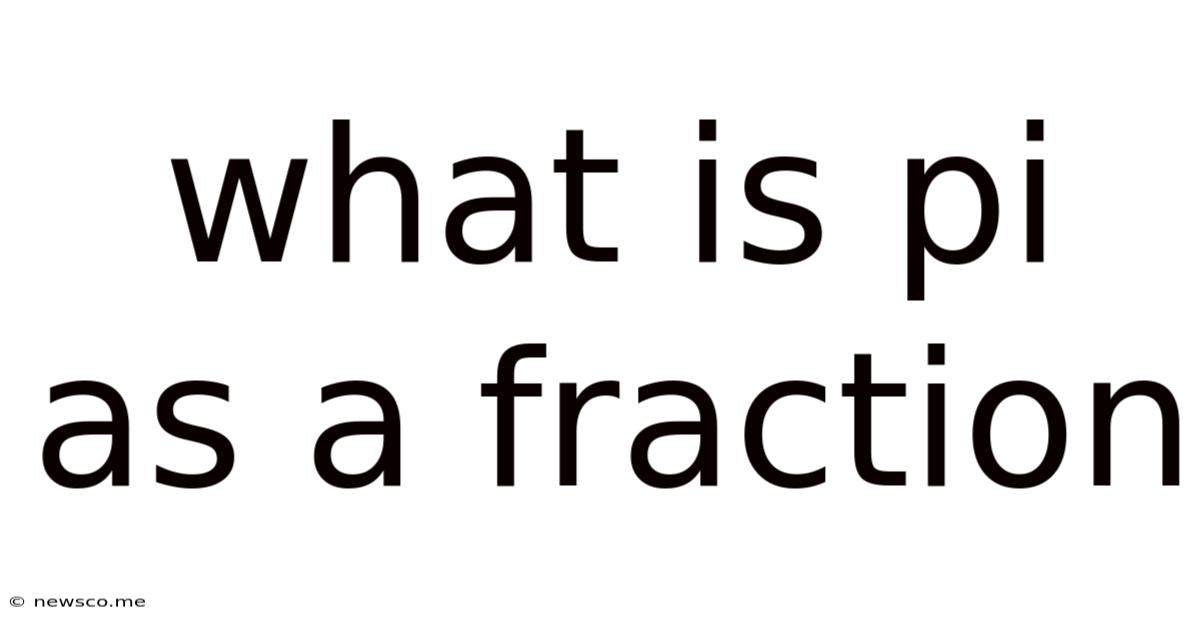What Is Pi As A Fraction
News Co
Mar 23, 2025 · 4 min read

Table of Contents
What is Pi as a Fraction? Unraveling the Infinite
Pi (π), the ratio of a circle's circumference to its diameter, is arguably the most famous mathematical constant. While we often represent it as approximately 3.14159, a fundamental question arises: can pi be expressed as a fraction? The short answer is no, not perfectly. Pi is an irrational number, meaning it cannot be expressed as a simple fraction (a ratio of two integers). However, we can explore the fascinating ways we approximate pi using fractions, understanding the limitations and the historical significance of these attempts.
The Irrationality of Pi: Why No Fraction Will Ever Suffice
The proof that pi is irrational is complex, involving advanced calculus and demonstrating that no two integers can perfectly represent the ratio. Several proofs exist, each showcasing the inherent incompatibility of pi with fractional representation. Simply put, the decimal expansion of pi continues infinitely without ever settling into a repeating pattern – a defining characteristic of irrational numbers. This infinite, non-repeating nature renders it impossible to capture pi's exact value using any fraction.
Exploring Early Attempts: Ancient Approximations of Pi
Long before the formal proof of pi's irrationality, civilizations around the globe attempted to approximate its value using fractions. These approximations, often embedded in religious texts and architectural marvels, demonstrate an early human understanding of this fundamental mathematical constant.
-
The Babylonians: Used a fraction of 3 1/8 (3.125) as an approximation of pi, a remarkably accurate estimation for its time.
-
The Egyptians: Employed a value close to 3.1605 in their mathematical calculations, derived from their approximation of the area of a circle.
-
Archimedes: A giant in the field of mathematics, Archimedes utilized the method of exhaustion – inscribing and circumscribing polygons around a circle – to narrow down the value of pi between 223/71 and 22/7. The fraction 22/7, while still an approximation, remains a popular way to quickly estimate pi, though its accuracy is relatively limited.
22/7: The Ubiquitous, Yet Imperfect, Fraction
The fraction 22/7 is frequently encountered as an approximation of pi. It is easy to remember and provides a reasonably close estimation. However, it's crucial to understand that this is not the true value of pi. The difference between 22/7 and the actual value of pi is approximately 0.00126. While seemingly small, this difference underscores the inability of any fraction to precisely represent the infinite nature of pi.
Using 22/7 in Calculations: While convenient for quick estimations, it's vital to remember its inherent inaccuracy in precision-critical applications. Using 22/7 will introduce errors into calculations, especially in larger or more complex geometric problems.
Beyond 22/7: More Accurate Fractional Approximations
Numerous other fractions provide closer approximations to pi than 22/7. These fractions, often called convergents, are derived from the continued fraction representation of pi. They offer progressively more accurate estimations, though none achieve true equality.
-
355/113: This fraction is remarkably accurate, offering an approximation of pi to six decimal places. It showcases the power of continued fractions in generating increasingly precise rational approximations.
-
Other Convergents: A plethora of other fractions, generated through the continued fraction expansion, provide even higher accuracy, although the complexity of the fractions increases significantly.
The Continued Fraction Representation of Pi: A Deeper Dive
The continued fraction representation offers a unique way to understand the nature of pi. It expresses pi as an infinite sequence of integers, providing a path to generate increasingly accurate rational approximations. While not a fraction itself, it serves as a powerful tool for constructing increasingly precise fractional representations. The continued fraction representation is inherently linked to the concept of best rational approximations—fractions that minimize the error between the fraction and the actual value of pi for a given denominator size.
Pi's Infinite Nature: Why Fractions Fail
The fundamental reason why pi cannot be expressed as a fraction boils down to its irrationality. The infinite, non-repeating decimal expansion of pi prevents it from being written as the ratio of two whole numbers. Any fractional representation will necessarily be an approximation, truncating the infinite nature of pi and introducing an inherent error.
Implications for Calculations: Accuracy vs. Simplicity
Choosing a fractional approximation for pi necessitates a careful balance between accuracy and simplicity. For less demanding applications, a simple fraction like 22/7 might suffice. However, for calculations requiring high precision, more accurate fractions (or even numerical methods employing a larger number of decimal places for pi) are necessary.
Conclusion: Pi and the Beauty of Approximation
While pi cannot be perfectly expressed as a fraction, the quest for increasingly accurate fractional approximations reveals the profound beauty of mathematics. From ancient civilizations employing simple fractions to modern mathematics employing sophisticated techniques like continued fractions, the history of approximating pi showcases human ingenuity in striving to understand and represent a fundamental constant of nature. While no fraction will ever truly capture pi's infinite nature, the search itself highlights the ongoing interaction between the theoretical and the practical, reminding us of the power and elegance of mathematical approximation.
Latest Posts
Related Post
Thank you for visiting our website which covers about What Is Pi As A Fraction . We hope the information provided has been useful to you. Feel free to contact us if you have any questions or need further assistance. See you next time and don't miss to bookmark.